By Stephen Akester
This article is based on an illustrated lecture given to the Society, at The Middle East Association, on 7 November 2006. The author is Director of MacAlister Elliott & Partners who advise on fisheries conservation and development, and have been working in Yemen since 1985.
After oil and water, fish constitutes Yemen’s third most important natural resource. With a coastline of 2230 km, Yemen benefits substantially from the fish wealth in its Exclusive Economic Zone, particularly in the Gulf of Aden. Fishing is a major source of employment and income in some of the country’s poorest rural areas, and the industry currently employs about 400,000 people. Fish has become a significant source of protein nutrition in the national diet, while fish exports have become an increasingly important source of foreign exchange: in 2002 export earnings totalled an estimated $35–45 million; fisheries contribute an estimated 2–3% to the country’s Gross Domestic Product.
Fish are landed at 49 locations on the Gulf of Aden coast, and at 31 locations along the Red Sea, but, nationally, facilities for the landing and processing of fish are inadequate. Yemen’s institutional capacity to plan development and investment programmes in the fisheries sector, and to implement policy are also limited. There is a serious lack of reliable data on which to build a strategy, and a lack of human resources to monitor the fishing industry and to enforce quality control.
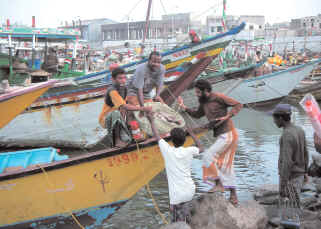 |
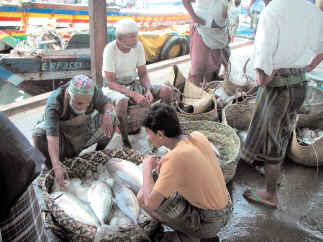 |
| Landing and marketing fish at Hodeidah, Red Sea coast. Photographs: Julian Lush |
The decline in marine research and in the collection of statistics means that the status of Yemen’s fish resources and fish catches can only be estimated. For example, the degree to which the country’s most valuable fish stocks such as cuttlefish, lobster, shrimp and demersal (sea bottom) fish have been exploited/depleted is unknown. Whilst the official cessation of industrial fishing in 2003, and the imposition of seasonal fishing limits on shrimp and cuttlefish have probably assisted the recovery of these stocks, there remains a vital requirement for data collection on fish landings, and for the effective management of the country’s fish resources, including the enforcement of fishing regulations.
Methods employed in the catching, landing, auctioning and marketing of fish in Yemen fall well below international standards. Inadequate quality control is a threat to the competitiveness and expansion of fish exports as well as to public health. The problem arises partly from the lack of coastal infrastructure and basic services, but also from the fact that smaller boats are not properly equipped to preserve fish catches; fishermen along the Red Sea coast regularly use ice, but those along the Gulf of Aden use it much less.
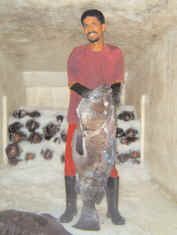 |
| Cold-storage of pelagic fish. |
The Ministry of Fish Wealth and the Marine Science Resources and Research Centre (MSRRC), let alone fisheries cooperatives, do not have the institutional structure, senior management or experienced staff to plan sector development.Moreover, the respective roles of the Ministry and MSRRC are ill-defined, and funding arrangements no longer reflect requirements.
Recently two major developments have taken place which create opportunities to help the Government of Yemen’s poverty reduction strategy: the cancellation of all foreign industrial fishing licences, and the rapid growth in the quantity and value of fish catches in the Governorates of Hadhramaut, Mahra and Hodeidah. This growth has been reflected in the increase in the number of fishing boats and in local employment.
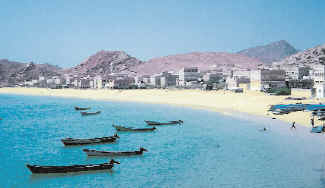 |
| Coastal fishing craft at Buroom, Hadhramaut, Gulf of Aden |
Changes which have caused growth in fisheries include increased investment in private sector transport, an increase in fish processing facilities, and an increase in boat-building and the number of fishing vessels, especially in Hadhramaut and along the Red Sea coast. These changes have been driven by strong demand for fish withinYemen and by export opportunities abroad (e. g. in Saudi Arabia and the Gulf, Jordan and Europe). Other factors are the import of modern fishing nets and ropes, and of larger outboard engines with more range and fishing power. However, it is probable that a large part of the increase in fish landings at Hodeidah and Mukalla results fromYemeni vessels buying in fish from Somalia, Djibouti and Eritrea.
In the past, most of the catch of an industrial fleet was processed on board for export, and was never landed in Yemen. By immediately processing and freezing freshly caught fish, the fleet was able to market a top quality product. The disappearance of the industrial fleet has inevitably raised questions about current and future quality control. Without improvement, the export of fish will be increasingly constrained byYemen’s inability to meet the standards required by importing countries.
Most of the boats operating in the Gulf of Aden still keep the fresh catch on the bottom of the boat without ice. But fishermen operating in the Red Sea, in response to persistent pressure from fish traders exporting to Saudi Arabia, generally use insulated boxes to keep their catch on ice. Most local markets are not yet quality conscious and do not pay premium prices for preserved fish, which explains why few fishermen in the Gulf of Aden use ice and insulated boxes.
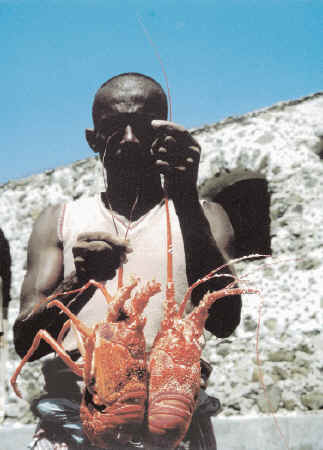 |
| Mukalla crayfish in palmier days. Photograph: Bini Malcolm |
To satisfy the current and future requirements of export markets, it will be necessary for prevailing methods of landing and auctioning fish to be fundamentally changed. Fish should be landed in ice boxes directly onto a fixed platform and then moved swiftly to a nearby auction floor (eventually the auction process should be executed in a temperature-controlled environment). Having been auctioned, fish should be quickly moved to waiting trucks or to temporary storage facilities operated by private traders.
The lack of actual data on fish landings and the low numbers of fishing vessels registered with cooperatives means that the monitoring of catch per unit of effort is not possible at a national level. However, data provided by the Yemeni Fish Exporters’ Association shows that catch per landing is decreasing, and discussion with local fishermen confirms this. Increasing numbers of fishing boats and the availability of modern fishing gear are reducing the benefits to each individual. Along the Red Sea this increased activity has been partly due to the fact that as the highlands dry out people have migrated down to the coast to earn a living from the sea. Yet the situation is not static. In 2003 there was a strong tuna migration and a substantial harvest of cuttlefish which enabled fishermen to reduce their dependence on coastal demersal fish. Since 2003, however, tuna and cuttlefish have been in short supply, forcing fishermen to concentrate on already over-exploited coastal demersal stocks, with diminishing returns. So long as there is no effective fisheries management and Yemen’s marine resources remain unpoliced, this situation can only deteriorate.
Vol 15. 2007


